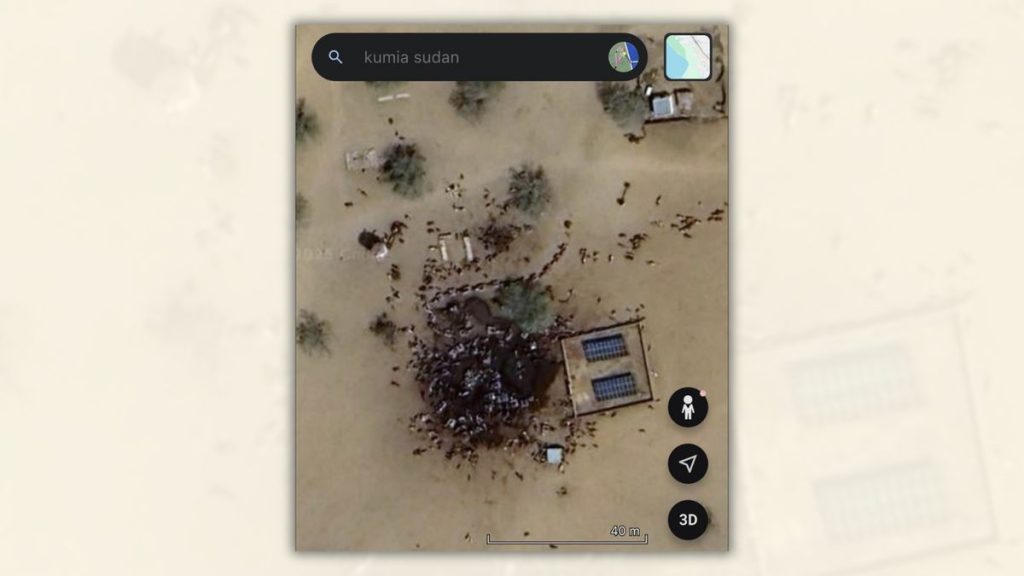Listen to the article
Satellite Image From Sudan Miscaptioned as Massacre Evidence, Fact-Checkers Confirm
A viral satellite image claimed to show evidence of a mass killing in Sudan has been debunked by fact-checkers and open-source intelligence experts. The Google Earth image, which began circulating on social media in early November 2025, was presented as showing dozens of human bodies lying in pools of blood in Kumia, Sudan.
One post on X, viewed millions of times, described it as “the most disturbing google earth image ever” and urged viewers to “speak on the genocide of Sudan.” Similar claims spread rapidly across Reddit, Facebook, and Threads, framed as evidence of atrocities in Sudan’s ongoing civil war.
Analysis by multiple verification experts has concluded that the image actually shows livestock gathered around a watering hole, not massacre victims. The satellite photo, which can indeed be found on Google Earth at coordinates 10°57’39″N, 26°24’52″E, dates back to March 2024 — not a recent discovery as many posts suggested.
“There are a lot of horrific images, videos and even satellite images you can use to show the horrors that are happening in Sudan. But this is a watering hole and those are animals,” explained Benjamin Strick, Director of Investigations at the Centre for Information Resilience, in a social media post addressing the mischaracterization.
Compelling evidence supporting this conclusion comes from historical satellite imagery. The same location, with comparable soil markings and an identifiable fence, appears in Google Earth images from March 2022, confirming the site has existed as a livestock watering point for years.
Apple Maps imagery of the exact same location provides clearer resolution that conclusively identifies the figures as four-legged animals, not human remains. Shadow analysis further strengthens this assessment, as the BBC’s verification team noted that the objects cast shadows in the same direction as nearby structures, indicating they are standing upright on four legs rather than lying flat.
Nathan Ruser, an analyst at the Australian Strategic Policy Institute, addressed the mischaracterization on social media: “The scale of murder and massacre by the UAE-backed RSF is unimaginable. But these are cow pens full of cows. The key thing when it comes to interpreting satellite imagery is knowing a ‘normal’ baseline.”
While this particular image was miscaptioned, experts emphasize that genuine satellite evidence documents actual atrocities elsewhere in Sudan. In late October 2025, after the Rapid Support Forces (RSF) seized control of El-Fasher, the capital of North Darfur, international observers documented widespread abuses against civilians.
The Humanitarian Research Lab (HRL) at Yale School of Public Health published detailed analysis based on authentic satellite imagery titled “Day Two of RSF Control: Mass Killings Continue in El-Fasher.” Their report identified “evidence of mass killings including door-to-door clearance operations and objects consistent with reported bodies on berm entrapping El-Fasher.”
According to HRL’s findings, verified satellite images from late October showed “lines of dark-colored objects consistent with groups of people stretching from the building to the gate of the compound and a group of people near the same gate.” Their analysis concluded this activity was “consistent with large groups of people being present on 27 October 2025, subsequently killed, and their bodies visible in satellite imagery on 28 October 2025.”
The United Nations has condemned what it described as “atrocities” in El-Fasher, while the International Criminal Court announced it is monitoring events in Sudan for possible “war crimes and crimes against humanity.”
Experts caution that satellite imagery alone requires careful interpretation and context. “We do not draw our conclusions solely from satellite images,” Strick told France24. “We cannot truly distinguish a genocide from satellite images alone, and therefore a multitude of factors must be taken into account.”
UN Secretary-General António Guterres recently warned that the Sudan civil war is “spiralling out of control,” highlighting the very real humanitarian crisis unfolding in the region that requires accurate reporting and assessment rather than misattributed evidence.
Fact Checker
Verify the accuracy of this article using The Disinformation Commission analysis and real-time sources.




7 Comments
While the initial viral claims about this satellite image were concerning, I’m glad the experts were able to provide the correct context. It’s a reminder that we must be vigilant against the spread of misinformation, even if it seems to support an important cause.
Kudos to the fact-checkers for taking the time to thoroughly investigate this case. Verifying the accuracy of visual evidence, especially around sensitive topics, is crucial to avoid inadvertently amplifying false narratives. A valuable lesson in the importance of due diligence.
This is a good example of how critical it is to scrutinize visual evidence, even from seemingly authoritative sources like Google Earth. The debunking of this misleading claim is a valuable lesson in the importance of rigorous fact-checking.
Appreciate the thorough investigation here. It’s concerning how easily misinformation can spread on social media, even when the intentions may be good. Fact-checking is so important, especially around issues of conflict and human rights.
Absolutely. Verifying claims, especially those with serious implications, should be a priority before sharing. Kudos to the fact-checkers for taking the time to properly analyze this satellite image and provide the accurate context.
Interesting to see the fact-checking on this satellite image from Sudan. It’s important to verify claims, especially around sensitive conflict zones, before spreading them online. Glad the experts could clarify what the image actually depicts.
Yes, it’s a good reminder to be cautious about viral social media posts making serious accusations without solid evidence. Fact-checking is crucial to avoid amplifying misinformation, even if the original intent was to raise awareness.